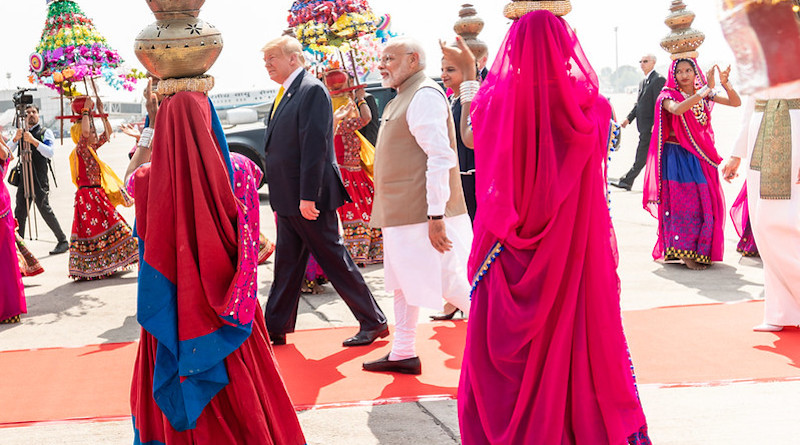US, India Deepen Bonds Despite Deal Disappointment – OpEd
By Arab News
By Andrew Hammond*
Donald Trump left New Delhi on Tuesday night after a two-day, three-city India trip, which saw him become only the seventh US president to visit the emerging-market giant. Economics and geopolitics drove the bilateral agenda between the world’s two largest democracies, yet political hoopla was also prominent between Trump and Narendra Modi.
With the pair of populist leaders recently suffering domestic setbacks, the “Namaste Trump” rally in Ahmedabad on Monday in front of 100,000 people was a remarkable public diplomacy event that reciprocated the “Howdy Modi” gathering in Houston last year. In this sense, the visit was a morale booster for both Modi and Trump, despite it coming amid the worst violence in New Delhi for a decade, with 13 killed in Hindu-Muslim communal clashes on Tuesday.
The talk of the town before the trip was the possibility of an interim comprehensive trade deal being reached, but this proved too far a stretch. As the US president asserted on Monday, he and much of the American business community badly want an agreement, given that “India will soon be the home of the biggest middle class anywhere in the world and, within less than 10 years, extreme poverty in the country is projected to completely disappear,” driving a huge consumer mass market.
Despite this disappointment, some US-India business agreements were signed in energy, telecoms and defense. Take the example of security, where Trump and Modi built on the progress that Washington has made with New Delhi after the latter was declared a major US defense partner in 2016. The defense-related agreements completed during the trip underline that such US-India deals have grown massively in the past decade, from close to zero in 2008 to more than $15 billion in 2019.
Underpinning this closer defense cooperation, the two countries signed the Communications Compatibility and Security Agreement in 2018, which then-Defense Minister Nirmala Sitharaman claimed elevated bilateral relations “to unprecedented heights.” This underlines how much the bilateral relationship has improved since the end of the Cold War, and there is now significant support across the political aisle in Washington favor of a strong US-India relationship, driven by the perceived strategic rationale for partnership, including shared concerns about China.
The deepening of bilateral relations with India is key to bringing greater credibility to Trump’s Indo-Pacific strategy, which has come in for criticism due to its perceived (under) ambition compared to China’s large-scale Belt and Road Initiative. Some remain underwhelmed by the Trump team’s strategy and assert that it will have less overall impact than the Obama administration’s commitment to the Trans-Pacific Partnership agreement with Asia-Pacific allies, the successor of which was ultimately signed in 2018 despite the Trump White House pulling the US out of the deal. To be sure, the Trump team has announced alternative plans to pursue bilateral trade deals in the region, including last September’s with Japan, but this has so far had only very limited success.
It is partly for this reason that Trump and Modi will continue to push hard for a comprehensive bilateral trade deal in the coming months. Washington is one of New Delhi’s top two trading partners along with China and trade in goods and services was a record $142.6 billion in 2018, up from $11.2 billion in 1995.
While this is largely celebrated, one challenge is that the US goods and services trade deficit with India shot up from $2 billion to $25.2 billion during the same period. This has fueled bilateral tensions, including Washington’s decision in 2019 to strip New Delhi of its US special trade status, which saw the Modi team retaliate with tariffs on some 28 categories of US goods.
It is not just the clash of Trump’s “America First” program with Modi’s “Made in India” agenda that has caused problems. Incentives for a deal have been undercut by the fall-off in India’s growth, which is estimated to be “only” 5 percent in 2019-2020.
In this context, the signing of any new comprehensive trade deal may have to wait until after November’s US presidential election, given the multiple compromises that will be needed. Before Trump’s trip, negotiators had been trying to put together a narrower agreement that would give the US greater access to India’s dairy and agriculture markets and reduce Indian tariffs on a host of US products, including almonds, chickpeas and motorcycles, but this fell flat too, for now at least.
Despite the disappointment of not securing even a pared-down deal this week, the Trump and Modi teams will now double down on negotiations with a view to building on the current warm ties. Both leaders sense a strategic opportunity not just to reach a comprehensive trade agreement, but also to embed their bilateral security alliance in the Indo-Pacific following Modi’s landslide re-election last year and the significant possibility Trump may be re-elected in November.
• Andrew Hammond is an Associate at LSE IDEAS at the London School of Economics.

